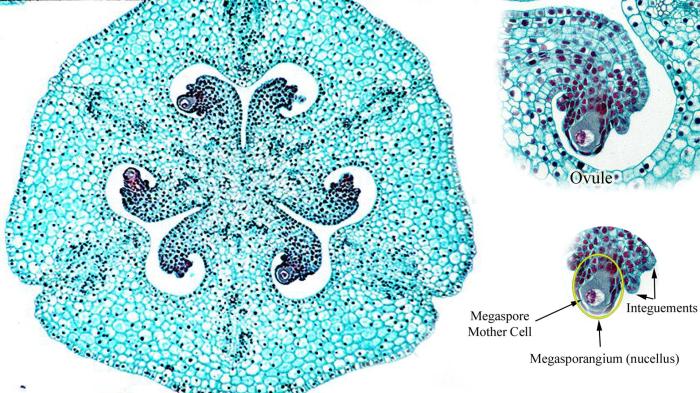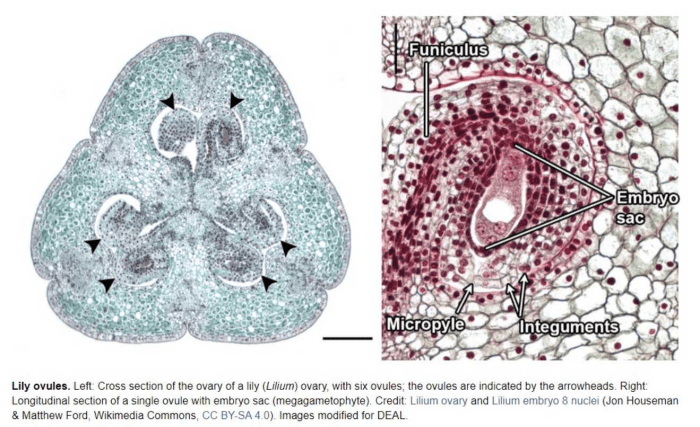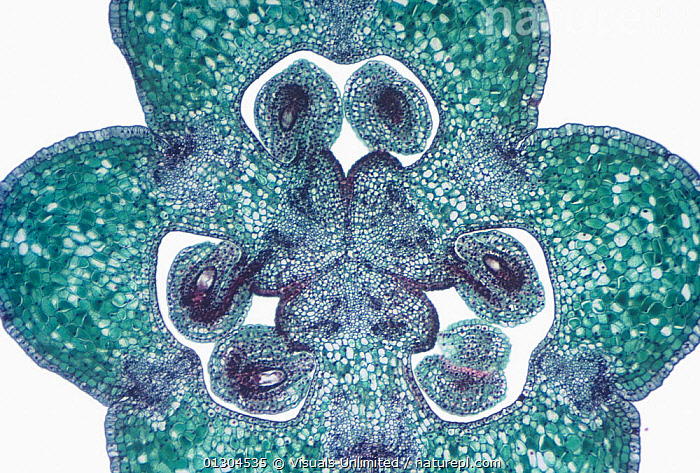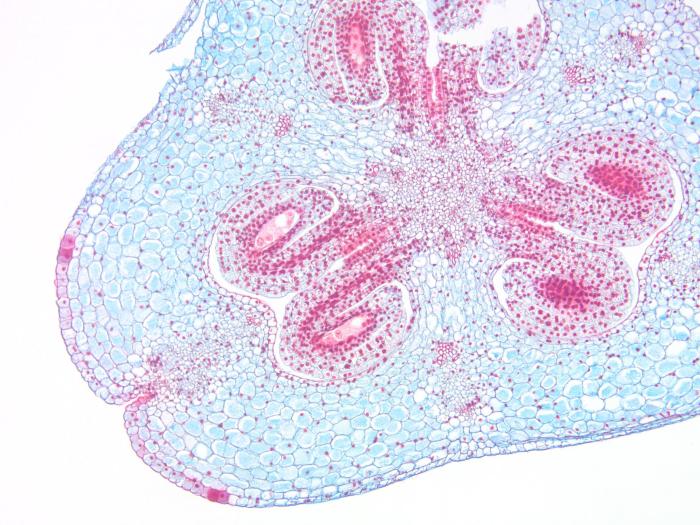Cross section of lily ovary – Embark on a captivating journey into the heart of a lily ovary, where the intricate dance of life unfolds. From the intricate network of its inner chambers to the miraculous process of fertilization, this cross-sectional exploration unravels the secrets of plant reproduction in an engaging and accessible way.
Delve into the anatomy of the lily ovary, where each part plays a crucial role in the development of new life. Witness the formation of ovules, the guardians of the future plant, and trace the path of the pollen tube as it navigates the ovary’s defenses to reach its destination.
Lily Ovary: Cross Section Of Lily Ovary

The lily ovary is a complex structure responsible for producing and protecting the seeds. It is located at the base of the flower and consists of several distinct parts, each with a specific function.
Cross-section of Lily Ovary
- Ovules:These are the structures that contain the female gametes (eggs). They are located in the center of the ovary and are surrounded by the integuments.
- Integuments:These are two layers of tissue that surround the ovules. The outer integument is called the testa, and the inner integument is called the tegmen.
- Nucellus:This is the tissue that surrounds the embryo sac within the ovule. It provides nourishment to the embryo sac and helps to protect it.
- Funiculus:This is the stalk that attaches the ovule to the placenta.
- Placenta:This is the tissue that lines the ovary and provides nourishment to the ovules.
Ovule Development

The development of ovules within the lily ovary is a crucial process in the reproductive cycle of the plant. This process involves a series of stages, beginning with megasporogenesis and culminating in fertilization.
Megasporogenesis
- Megasporogenesis initiates with a diploid cell within the nucellus, known as the megaspore mother cell.
- This cell undergoes meiotic division, resulting in the formation of four haploid megaspores.
- Three of these megaspores degenerate, leaving a single surviving megaspore.
Megaspore Development
- The surviving megaspore undergoes three rounds of mitosis, producing eight haploid nuclei.
- These nuclei become organized into an embryo sac, which is enclosed within the ovule.
Fertilization
- During fertilization, a pollen tube containing two sperm cells enters the ovule through the micropyle.
- One sperm cell fuses with the egg cell, forming a diploid zygote, while the other sperm cell fuses with the two polar nuclei, forming a triploid endosperm.
- The endosperm serves as a source of nutrients for the developing embryo.
Role of the Ovary
- The ovary provides a protective environment for the developing ovules.
- It also supplies nutrients to the ovules through the placenta, which is a specialized tissue that connects the ovules to the ovary wall.
- The ovary plays a crucial role in ensuring the successful development and maturation of the ovules, which are essential for seed production.
Pollen Tube Growth
Once a pollen grain lands on the stigma of the lily, it begins to germinate and produces a pollen tube. The pollen tube is a long, slender structure that grows through the style and into the ovary, carrying the sperm cells to the ovules.
The growth of the pollen tube is guided by a chemical gradient. The ovules release a substance that attracts the pollen tube, and the pollen tube follows this gradient until it reaches the ovules.
Mechanisms Preventing Self-Fertilization
Self-fertilization is the fertilization of an ovule by a pollen grain from the same plant. This can lead to inbreeding depression, which is a reduction in fitness due to the expression of harmful recessive alleles.
Lilies have several mechanisms in place to prevent self-fertilization. One mechanism is the timing of pollen release and stigma receptivity. The pollen is released before the stigma is receptive, so that the pollen cannot fertilize the ovules of the same flower.
Another mechanism is the presence of self-incompatibility genes. These genes prevent the pollen tube from growing through the style if the pollen and stigma are from the same plant.
Fertilization and Seed Development

Following pollination, the sperm cells travel down the style and enter the ovary. Fertilization occurs within the ovule, where a sperm cell fuses with the egg cell, resulting in the formation of a zygote.
A cross section of a lily ovary reveals an intricate arrangement of ovules and placentae. For those seeking further knowledge, I recommend exploring the wit and wisdom module 0 . It offers a comprehensive guide to the structure and function of the lily ovary, providing a deeper understanding of this fascinating reproductive organ.
Zygote Development
The zygote undergoes a series of mitotic divisions, forming an embryo with a root, stem, and one or two cotyledons. The embryo is surrounded by a protective seed coat, which develops from the integuments of the ovule.
Seed Coat Development
The seed coat consists of an outer layer called the testa and an inner layer called the tegmen. The testa is typically hard and waterproof, protecting the embryo from damage and desiccation. The tegmen is thinner and often contains nutrients for the developing embryo.
Comparative Analysis

Cross-sections of lily ovaries exhibit similarities and differences when compared to those of other flowering plants. Understanding these variations provides insights into the evolutionary history and adaptations of flowering plants.
Similarities
Many flowering plants, including lilies, possess ovaries with a central placenta surrounded by ovules. The ovules are typically arranged in a radial pattern, attached to the placenta by funicles. The ovary wall consists of an outer epidermis, parenchyma tissue, and an inner epidermis.
These structural features facilitate the protection and nourishment of the ovules.
Differences
Variations in ovary structure among flowering plants reflect adaptations to different pollination and seed dispersal mechanisms. For example, some plants have ovaries with a single chamber (unilocular), while others have ovaries with multiple chambers (multilocular). The number and arrangement of ovules within the ovary can also vary significantly.
These differences influence the efficiency of pollination, seed production, and seed dispersal.
Evolutionary Significance, Cross section of lily ovary
The variations in ovary structure among flowering plants are a result of natural selection. Over time, different plant species have evolved ovary structures that optimize their reproductive success in specific environments. For instance, plants that rely on wind pollination tend to have ovaries with exposed stigmas to facilitate pollen capture, while plants that are pollinated by animals may have ovaries with enclosed stigmas to protect the ovules from damage.
Essential FAQs
What is the function of the lily ovary?
The lily ovary serves as the protective chamber where ovules develop and fertilization occurs, leading to the formation of seeds.
How does the pollen tube reach the ovules?
Guided by chemical signals, the pollen tube extends through the style and ovary, penetrating the ovules to deliver sperm cells for fertilization.
What is the significance of the lily ovary’s cross-section?
Examining the cross-section of a lily ovary provides valuable insights into the structural adaptations and processes that facilitate successful reproduction in flowering plants.